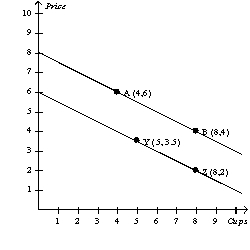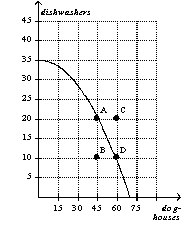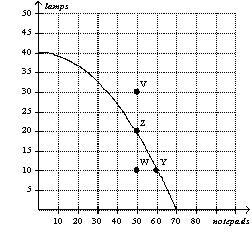A) Few economic models incorporate assumptions.
B) Different economic models employ different sets of assumptions.
C) Good economic models attempt to mimic reality as closely as possible.
D) Economic models, to be accepted, must be tested by conducting experiments.
Correct Answer

verified
Correct Answer
verified
Multiple Choice
A model that shows how dollars flow through markets among households and firms is called the
A) production possibilities frontier.
B) circular-flow diagram.
C) demand and supply diagram.
D) comparative advantage model.
Correct Answer

verified
Correct Answer
verified
Multiple Choice
Figure 2-15
Relationship between Price and Cups of Coffee
 -Refer to Figure 2-15.A movement from point A to point Z is called
-Refer to Figure 2-15.A movement from point A to point Z is called
A) a shift in demand.
B) a movement along the demand curve.
C) a shift in supply.
D) a movement along the supply curve.
Correct Answer

verified
Correct Answer
verified
Multiple Choice
A survey which sought the opinion of professional economists on fourteen propositions about economic policy found that
A) the respondents were almost equally divided on the propositions.
B) the respondents favored the propositions by a slight margin.
C) the respondents disagreed with the propositions by a slight margin.
D) there was overwhelming endorsement of the propositions among the respondents.
Correct Answer

verified
Correct Answer
verified
Multiple Choice
Table 2-5
 -Refer to Table 2-5.Table 2-5 shows one set of production possibilities.What is the opportunity cost of an increase in the production of coffee from 350 pounds to 650 pounds?
-Refer to Table 2-5.Table 2-5 shows one set of production possibilities.What is the opportunity cost of an increase in the production of coffee from 350 pounds to 650 pounds?
A) 400 dozen cookies
B) 300 dozen cookies
C) 200 dozen cookies
D) 200 pounds of coffee
Correct Answer

verified
Correct Answer
verified
Multiple Choice
In the circular-flow diagram,which of the following items does not flow from households to firms?
A) revenue
B) land, labor, and capital
C) factors of production
D) profit
Correct Answer

verified
Correct Answer
verified
Multiple Choice
Positive statements are not
A) descriptive.
B) prescriptive.
C) claims about how the world is.
D) made by economists speaking as scientists.
Correct Answer

verified
Correct Answer
verified
Multiple Choice
Historical episodes are
A) valuable to economists because they allow economists to see how the science of economics has evolved.
B) valuable to economists because they allow economists to evaluate economic theories.
C) not of concern to economists because economics is about predicting the future, not dwelling on the past.
D) not of concern to economists because the exact circumstances of historical episodes are unlikely to be observed again.
Correct Answer

verified
Correct Answer
verified
True/False
According to John Maynard Keynes,an economist must possess a rare combination of skills including being a mathematician,historian,statesman,and philosopher.
Correct Answer

verified
Correct Answer
verified
Multiple Choice
Figure 2-9
 -Refer to Figure 2-9,Panel (a) .The opportunity cost of one computer is highest when the economy produces
-Refer to Figure 2-9,Panel (a) .The opportunity cost of one computer is highest when the economy produces
A) 0 computers.
B) 6 computers.
C) 10 computers.
D) 12 computers.
Correct Answer

verified
Correct Answer
verified
Multiple Choice
A demand curve displaying the relationship between the price of cars and the quantity demanded of cars should have a slope that is
A) less than 0.
B) between zero and 1.
C) between one and infinity.
D) undefined.
Correct Answer

verified
Correct Answer
verified
Multiple Choice
Table 2-5
 -Refer to Table 2-5.Table 2-5 shows one set of production possibilities.Which of the following statements is correct?
-Refer to Table 2-5.Table 2-5 shows one set of production possibilities.Which of the following statements is correct?
A) The opportunity cost of a dozen cookies does not depend on how many pounds of coffee are being produced.
B) The opportunity cost of a dozen cookies increases as more cookies are produced.
C) The opportunity cost of a dozen cookies decreases as more cookies are produced.
D) The opportunity cost of a pound of coffee decreases as more coffee is produced.
Correct Answer

verified
Correct Answer
verified
True/False
Figure 2-14
 -Refer to Figure 2-14.It is possible for this economy to produce 45 doghouses and 30 dishwashers.
-Refer to Figure 2-14.It is possible for this economy to produce 45 doghouses and 30 dishwashers.
Correct Answer

verified
Correct Answer
verified
True/False
Two variables that have a negative correlation move in opposite directions.
Correct Answer

verified
Correct Answer
verified
Multiple Choice
Unemployment would cause an economy to
A) produce inside its production possibilities frontier.
B) produce on its production possibilities frontier.
C) produce outside its production possibilities frontier.
D) experience an inward shift of its production possibilities frontier.
Correct Answer

verified
Correct Answer
verified
Multiple Choice
Almost all economists agree that rent control
A) has no effect on the rental income of landlords.
B) allows the market for housing to work more efficiently.
C) adversely affects the availability and quality of housing.
D) is a very inexpensive way to help the most needy members of society.
Correct Answer

verified
Correct Answer
verified
Multiple Choice
A survey of professional economists revealed that more than three-fourths of them agreed with a number of statements,including which of the following?
A) Tariffs and import quotas usually reduce general economic welfare.
B) A large federal budget deficit has an adverse effect on the economy.
C) Minimum wage increases unemployment among young and unskilled workers.
D) All of the above are correct.
Correct Answer

verified
Correct Answer
verified
Multiple Choice
Figure 2-4
 -Refer to Figure 2-4.The opportunity cost of obtaining 10 additional lamps by moving from point W to point Z is
-Refer to Figure 2-4.The opportunity cost of obtaining 10 additional lamps by moving from point W to point Z is
A) 0 notepads.
B) 10 notepads.
C) 50 notepads.
D) None of the above; the economy cannot move from point W to point Z.
Correct Answer

verified
Correct Answer
verified
Multiple Choice
Which of the following would likely be studied by a microeconomist rather than a macroeconomist?
A) the effect of foreign direct investment on economic growth
B) the effect of a sales tax on the cigarette industry
C) the effect of an investment tax credit on the economy's capital stock
D) the effect of a war on government spending
Correct Answer

verified
Correct Answer
verified
Multiple Choice
Suppose that someone makes the argument that because empty alcohol containers are found at many accidents,the containers cause accidents.This would be an example of
A) sound logic.
B) reverse causality.
C) omitted variables.
D) bias.
Correct Answer

verified
Correct Answer
verified
Showing 361 - 380 of 535
Related Exams